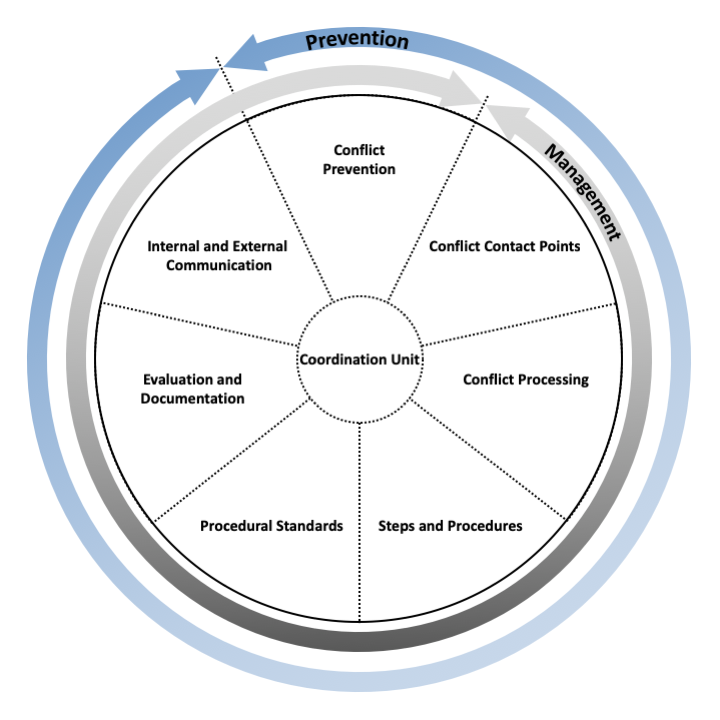Overview
Conflict Prevention and Management System in Trans-SEC
Measures of conflict prevention and management (CPM) were integral part of the Trans-SEC project. Large-scale international collaborative research projects are complex systems and their management is challenging. Such projects tend to be international, inter-organizational, interdisciplinary, virtual, temporary, and third-party funded. These types of projects also tend to be transdisciplinary, with substantial stakeholder involvement in the process.
Lean management structures with limited financial and personal resources allocated to overall coordination and management are typical in scientific research collaborations. A decentralized structure prevails, with relatively flat hierarchies between the partnering organizations and responsibilities split between project members. Project managers have limited decision and sanctioning power and are usually scientists by profession. Typically, they are not specifically trained in project, human resource, or conflict management.
Conflicts are inevitable in such complex setting and can lead to project failure if not managed well. For example, 79.3 % of Trans-SEC project members reported having personally experienced some level of conflict in the project (Löhr et al., 2017). It is at this point that CPM-measures come into play, to support and help overcome crucial points.
Escalation of conflict in research projects can have damaging effects with risk of project failure. Few resources are available to cope with conflict costs, such as delays in delivery, poor data, staff absenteeism, replacement of staff, and extensive conflict management processes. In addition, well-known coping mechanisms, such as budget top-up or time extensions, are difficult to obtain from third-party funding.
CPM Structure in Trans-SEC
Based on previous work experience, Trans-SEC management delegated the design of a Conflict Prevention and Management System (CPM-System) to a Coordination Unit based in Germany. During the initial three years, a set of mechanisms and activities were designed and implemented to both prevent conflict escalation and provide support in cases of conflict. Accounting for the project’s structure, a decentralized CPM-System was established with organizational conflict contact points appointed at each partner organization and a national CPM coordinator elected for Tanzania. Various activities and mechanisms were implemented: Conflict prevention measures and activities such as teambuilding and team supervision, workshops on intercultural awareness, communication, and conflict management, coaching, and a reflective jour-fixe for project coordination. If needed, individuals could contact any conflict contact point they wished. An external consultant was also put in place, offering moderation of processes with high conflict potential, such as board meetings, as well as coaching and mediation on demand. Continuous evaluation of the CPM-System ensured documentation and shared with project members via the website, e-mails as well as conference presentations.
The Viadrina component model on conflict management served as conceptual frame for the CPM-System in Trans-SEC. The model was developed based on conflict management practice in the German business sector with positive results reported. The implementation of CPM measures was accompanied scientifically. It was found that conceptual adaptations of the Viadrina model are needed in order to fit the research environment. Key finding is (a) the need to decentralized conflict management structures to account for the project’s organizational set-up as well to (b) integrate a component of conflict prevention to keep levels of conflict low and prevent escalation. An adapted model of conflict prevention and management for international and interdisciplinary projects got derived, that can serve as conceptual model for future projects (Figure 1; Löhr et al., 2017).

Effectiveness of CPM in a research project
The majority of Trans-SEC members reported a positive impact of the CPM component on communication, intercultural understanding, levels of trust as well as prevention of conflict escalation. 80% of project members recommended including such support measure in all international and interdisciplinary research projects. The large majority of those members who participated in workshops on communication and conflict management stated that CPM improved their conflict handling skills and that the workshops gave them knowledge and skills that they can use beyond the project.
First spill-over effects support the positive findings. Project members report the transfer of knowledge to the stakeholder level by applying new skills in case of conflict between stakeholder groups. Conflict management structures were set up in home institutions, as in the case of the Tanzania Federation of Cooperatives (TFC) that works with farmers groups across the country. Project members requested additional CPM workshops at their home institutions and integrated CPM in subsequent projects (Löhr et al., 2017).
More information on CPM-System design and evaluation can be found in a number of publications.



